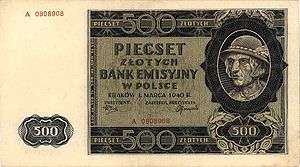Młynarki
Młynarki [mwɨˈnarkʲi] was the popular name for the currency notes of the General Government (part of German occupied Poland) during World War II, issued by the German controlled Bank of Issue in Poland. They were named after the president of the bank, Feliks Młynarski.[1]

History
After the German invasion of Poland and the ensuing occupation, the Reichsbank decided not to introduce German currency there, as it did not want to increase the money supply.[2] Various Polish banks and credit institutions were temporarily closed, while some of their assets were nationalized by the German government. Many people lost their savings.[2][3] On 15 December 1939, Hans Frank, the governor of the General Government, an administrative unit for most of occupied Poland, passed a decree creating a new bank, the Bank of Issue in Poland (Bank Emisyjny), which began operating in April the following year .[2][4] The bank was headed by Feliks Młynarski, with the approval of the Polish government in exile.[2][1]
The official exchange rate was set at 2 złoty for 1 reichsmark.[2] The exchange system was meant to boost the German economy at the expense of the Polish one.[2][2] The black market exchange rate varied between three and four złotys to a reichsmark.[2]
The most famous of the notes was the 500 złoty note, the góral ("highlander" or "mountaineer") named after the image of a góral on its front.[1] The note is still popular among currency collectors. Counterfeiting of the currency was rampant.[5] The name was also reflected in one of the actions of the Polish resistance, "Operation Góral", a 1943 heist in which the insurgents took over a currency shipment worth over a million contemporary US dollars.[6][7] The 500 note was also the standard "unit of corruption"; the minimum bribe that representatives of the occupation authorities required to facilitate the carrying out of illicit activity.[8] In that role it was immortalized in the popular underground street song of Warsaw, Siekiera, motyka.[9]
The currency notes were used exclusively within the General Government, but not the Polish areas annexed by Nazi Germany.[2] They were withdrawn from circulation between 1944 and 1945.[2]
References
- Gk, Pap. "Tynfy, młynarki, górale – Wiadomości biznesowe – Newsweek.pl". Biznes.newsweek.pl. Archived from the original on 2014-07-14. Retrieved 2014-06-09.
- Andrzej Gojski, Etapy i cele niemieckiej polityki bankowej w GG. Plany niemieckie wobec Generalnego Gubernatorstwa w latach 1939–1945, BANK I KREDYT, August 2004, pdf Archived 2009-03-05 at the Wayback Machine
- Zbigniew Landau, Jerzy Tomaszewski, The Polish Economy in the Twentieth Century, Published by Routledge, 1985, ISBN 0-7099-1607-8, Google Print, pp.168–169
- Jerzy Jan Lerski (1996). Historical Dictionary of Poland, 966-1945. Greenwood Publishing Group. p. 26. ISBN 978-0-313-26007-0.
- ""English" counterfeit banknote 500 zloty 1940 issued by Bank Emisyjny, commonly nicknamed "mountaineer"". Atsnotes.com. Retrieved 2014-06-09.
- Stowarzyszenie Pamięci Powstania Warszawskiego 1944. "Powstanie Warszawskie 1944 – Oficjalna strona Stowarzyszenia Pamięci Powstania Warszawskiego 1944". Sppw1944.org. Retrieved 2014-06-09.
- "Strona 5". Niewiarygodne.pl. Archived from the original on 2014-06-09. Retrieved 2014-06-09.
- Łukaszewska-Bułat, Irena (2005). Droga powrotna: warszawskie Termopile 1944 : wspomnienia powstańców (in Polish). Fundacja "Warszawa Walczy 1939-1945". pp. 40–45.
- Res humana (in Polish). Rada Krajowa Towarzystwa Kultury Świeckiej. 2005. p. 12.
| Wikimedia Commons has media related to Banknotes of Poland (1939-1945). |